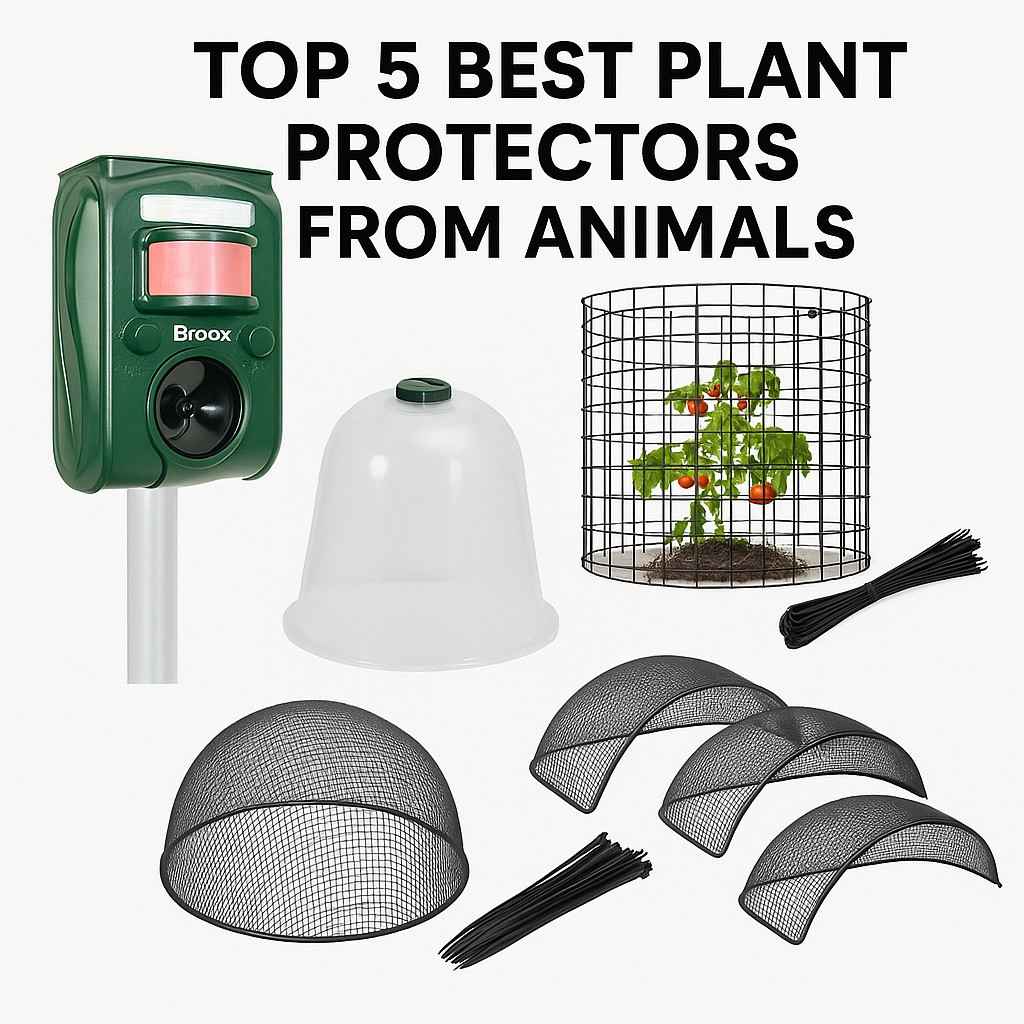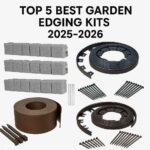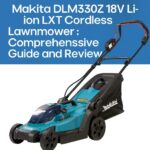Gardening can be one of the most rewarding hobbies out there, whether you’re growing veggies in your backyard, tending to flower beds, or just keeping a few potted plants on your patio. But let’s face it, animals love our gardens just as much as we do—sometimes even more. Deer munch on tender leaves, rabbits nibble at stems, squirrels dig up bulbs, birds peck at fruits, and even neighborhood cats can turn your flowerbed into a litter box. These critters can turn a thriving garden into a disaster zone overnight, leaving gardeners frustrated and out of pocket from replacing damaged plants.
That’s where plant protectors come in. These handy tools and devices are designed to keep unwanted visitors at bay without harming the animals or the environment. They’re essential for anyone who wants to protect their hard work, especially if you live in areas with high wildlife activity like suburbs or rural spots. With climate changes and urban expansion pushing more animals into human spaces, the need for effective plant protection is bigger than ever in 2025–2026.
In this article, we’ll dive into the top options available right now, based on popular choices from reliable sources. We’ll cover what to look for, different types, our picks for the best five, maintenance tips, and more. Whether you’re a newbie gardener or a seasoned pro, there’s something here to help you safeguard your green space.
What to Look for in a Good Plant Protector
Choosing the right plant protector isn’t just about grabbing the first thing you see online. You want something that fits your specific needs, lasts through the seasons, and actually works. Here’s a breakdown of the key factors to consider:
- Material and Durability: Look for materials that stand up to the elements and animal attempts. Plastic might be lightweight and cheap, but it can crack in cold weather. Metal mesh or wire is tougher against chewing critters like rabbits or squirrels. Biodegradable options, like certain nets or sprays, are great if you want eco-friendly choices that break down over time without leaving waste.
- Ease of Installation: Nobody wants to spend hours setting up. Opt for protectors that are quick to assemble, like stake-in-the-ground devices or clip-on meshes. Permanent fixtures, such as fences, might require more effort upfront but offer long-term peace of mind. Think about your garden size—smaller setups for pots versus larger ones for beds.
- Effectiveness Against Specific Animals: Not all protectors handle every pest. For deer, you need height and repellents; for birds, fine netting; for burrowing animals like moles, underground barriers or ultrasonic devices. Check what the product targets—rabbits, deer, birds, rodents, or a combo.
- Weather Resistance: Your protector has to endure rain, sun, wind, and maybe snow. UV-resistant materials prevent fading and cracking, while waterproof electronics (for devices like sprinklers) keep things running. IP ratings, like IP65 for dust and water protection, are a good sign for outdoor gadgets.
- Price vs. Value: You can find budget options under $20, but they might not last. Mid-range ( $30–$60) often balances cost with quality, while premium ones over $50 might include advanced features like solar power. Consider longevity— a pricier item that lasts years is better value than cheap ones you replace annually.
By weighing these, you’ll pick a protector that not only works but also saves you time and money in the long run.
Types of Plant Protectors
Plant protectors come in various forms, each suited to different threats and garden styles. Here’s a quick overview of the main categories:
- Physical Barriers (Fences, Cages, Mesh Covers): These create a literal wall between animals and your plants. Wire cages protect individual plants, while fences enclose whole areas. Mesh nets drape over beds to block birds or insects. They’re reliable, low-maintenance, and humane, but can look a bit industrial if not chosen carefully.
- Repellent Devices (Ultrasonic, Motion-Activated Sprinklers): Tech-savvy options use sound, light, or water to scare animals away. Ultrasonic emitters produce high-frequency noises irritating to pests but inaudible to humans. Motion sprinklers spray water when they detect movement. Many are solar-powered for eco-friendliness. They’re great for larger areas but might need batteries or hose connections.
- Natural Deterrents (Eco-Friendly Sprays, Scent-Based Options): These use smells or tastes animals hate, like garlic, pepper, or predator scents. Granules or sprays apply directly to plants or soil. They’re biodegradable, safe for pets and wildlife, and blend into natural gardening. However, they require reapplication after rain and might not work in heavy infestations.
Mixing types often gives the best results—for example, a barrier plus a repellent for double protection.
Top 5 Best Plant Protectors (2025–2026)
After researching popular Amazon listings and user feedback, here are our top picks for 2025–2026. These stand out for effectiveness, ease of use, and value. We’ve included a mix of types to cover different needs.
#1 Broox 2025 Upgraded Solar Animal Repellent
Overview: The Broox 2025 model is a humane, tech-based repellent that uses ultrasonic waves and flashing lights to deter a wide range of animals without chemicals or traps. It’s perfect for gardens plagued by deer, cats, squirrels, and more. Solar-powered, it charges during the day for night-time protection.
Key Features: Solar panel for eco-friendly power; motion sensor with adjustable sensitivity; ultrasonic frequencies targeting specific pests; IP65 waterproof rating; covers up to 1,100 square feet. Includes stake for easy ground installation.
Pros: Humane and non-lethal; no ongoing costs after purchase; works day and night; easy setup in minutes; effective against multiple animals based on reviews.
Cons: May not deter all animals (some users report habituation over time); requires direct sunlight for optimal charging; occasional false triggers from wind or leaves.
Best For: Large yards or gardens with varied pests like deer and rodents. Check it out on Amazon.
#2 Aqua Joe AJYP101 Yard Patrol Motion Activated Sprinkler
Overview: This motion-activated sprinkler blasts a quick spray of water to startle animals away from your plants. It’s a fun, effective way to protect lawns, flower beds, and veggie patches from cats, dogs, deer, and birds. Connects to your garden hose for unlimited use.
Key Features: 120-degree motion sensor with day/night modes; 360-degree spray rotation; adjustable range up to 42 feet; covers 5,700 square feet; three detection modes for different animals; durable metal stake.
Pros: Humane and entertaining to watch; waters your garden as a bonus; customizable settings; strong build for outdoor use; high success rate in reviews for deterring deer and cats.
Cons: Requires a hose connection (not wireless); can waste water if triggered often; not ideal for very small spaces or drought areas.
Best For: Medium to large gardens where water access is easy, especially for ground-level pests. Available on Amazon.
#3 TANIVO 18pcs Plant Protectors from Animals
Overview: These wire mesh cages provide physical protection for individual plants or small groups, keeping out rabbits, chickens, squirrels, and other small animals. The pack includes multiple pieces for versatile use in gardens or pots.
Key Features: 6-pack with 18 pre-bent metal meshes; includes zip ties and stakes for assembly; durable wire construction; 13.5″ diameter x 14″ height; rust-resistant for long-term use.
Pros: Sturdy and reusable; easy to install and store; effective barrier without harming animals; affordable for multiple plants; good airflow and light penetration.
Cons: Assembly required (though simple); might not stop larger animals like deer; visible in the garden, so not the most aesthetic.
Best For: Protecting seedlings, veggies, or flowers from small ground animals in raised beds. Find it on Amazon.
#4 Garden Mesh Netting Kit (10x30Ft Ultra Fine Mesh)
Overview: This large netting acts as a barrier to prevent birds, squirrels, and insects from reaching your plants while allowing sun, air, and water through. Ideal for draping over fruit trees, veggie rows, or greenhouses.
Key Features: 10 ft x 30 ft size; ultra-fine 0.8mm x 1mm mesh; heavy-duty polyethylene material; reusable and cuttable; includes clips for securing; protects against birds, deer, and pests.
Pros: Large coverage for big areas; lightweight yet durable; eco-friendly and non-toxic; easy to install with stakes or frames; high effectiveness for aerial threats like birds.
Cons: Can tangle if not handled carefully; needs support structures; may require removal for harvesting or weeding.
Best For: Fruit and vegetable gardens vulnerable to birds or flying insects. Purchase on Amazon.
#5 Bonide Repels-All Animal Repellent Granules
Overview: A natural, granule-based repellent that uses strong scents to keep animals away from plants. Sprinkle around your garden to deter rabbits, deer, squirrels, and more without sprays or devices.
Key Features: 3 lbs ready-to-use granules; biodegradable ingredients like garlic and eggs; covers up to 1,500 square feet; pet and people safe; lasts up to 2 months; rain-resistant formula.
Pros: All-natural and safe for the environment; easy application; no setup needed; effective for a broad range of animals; affordable and long-lasting.
Cons: Strong odor initially (fades over time); requires reapplication after heavy rain; not a physical barrier, so may need combining with others.
Best For: Organic gardeners wanting a chemical-free option for general pest control. Get it on Amazon.
Comparison Table
| Product | Type | Best For |
|---|---|---|
| Broox 2025 Upgraded Solar Animal Repellent | Repellent Device (Ultrasonic) | Varied pests like deer and squirrels |
| Aqua Joe AJYP101 Yard Patrol Motion Activated Sprinkler | Repellent Device (Sprinkler) | Ground animals like cats and deer |
| TANIVO 18pcs Plant Protectors | Physical Barrier (Mesh Cages) | Small animals like rabbits |
| Garden Mesh Netting Kit | Physical Barrier (Netting) | Birds and insects |
| Bonide Repels-All Animal Repellent Granules | Natural Deterrent | Broad range including rabbits and deer |
This table helps you quickly compare options. Ratings are based on average Amazon reviews, and prices can fluctuate—check current listings.
How to Maintain and Use Plant Protectors Properly
Getting the most out of your plant protector means using and caring for it right. Here’s some practical advice:
- Cleaning and Storage Tips: For barriers like meshes or cages, rinse off dirt with a hose and let dry before storing to prevent rust. Ultrasonic devices: Wipe sensors clean and store indoors during off-seasons. Sprinklers: Drain water to avoid freezing in winter. Natural granules: No cleaning needed, but store in a cool, dry place.
- Seasonal Maintenance: In spring, inspect for damage from winter weather. Summer: Check for UV wear and reposition as plants grow. Fall: Reinforce against hungry animals prepping for winter. Winter: Remove or cover sensitive electronics; barriers can stay if snow-resistant.
- When to Replace or Upgrade: If effectiveness drops (e.g., animals ignore repellents), it might be time for a new one. Look for wear like torn nets or faded batteries. Upgrade if your garden expands or new pests appear—maybe from a basic net to a smart device.
Proper use extends life and keeps your plants safe year-round.
Expert Tips for Preventing Animal Damage
Beyond protectors, here are some pro strategies to boost your defenses:
- Complementary Methods: Use lighting like solar motion lights to scare nocturnal visitors. Natural repellents include planting marigolds or garlic as companions that deter pests. Fence gaps or add chicken wire underground for burrowers.
- Common Mistakes to Avoid: Don’t rely on one method—animals adapt. Avoid toxic chemicals that harm wildlife or pollinators. Place protectors too late; start early in the season. Forget to monitor; check regularly for breaches.
Combining these with your chosen protector creates a multi-layered defense.
Conclusion
Protecting your plants from animals doesn’t have to be a battle. With options like the Broox ultrasonic repellent, Aqua Joe sprinkler, TANIVO cages, garden netting, and Bonide granules, you can find the perfect fit for your garden in 2025–2026. Remember, the best choice depends on your local animals, garden size, and preferences—physical barriers for direct protection, devices for tech ease, or naturals for eco-friendliness.
Key takeaways: Prioritize durability, ease, and specificity; maintain properly; and layer methods for best results. Your garden will thank you with bountiful blooms and harvests. Check current prices on Amazon and start protecting today!







